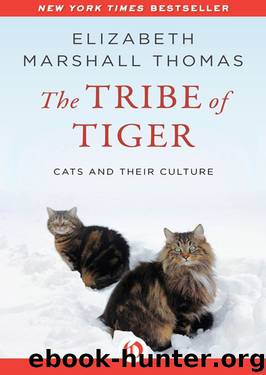The Tribe of Tiger: Cats and Their Culture by Elizabeth Marshall Thomas

Author:Elizabeth Marshall Thomas [Thomas, Elizabeth Marshall]
Language: eng
Format: epub
ISBN: 9781504015578
Publisher: Open Road Media
Published: 2015-07-14T04:00:00+00:00
What was the importance to the lions of the truce between them and the people, and what did the lions have to do to keep the truce? To consider the question, one must consider lion life. Probably the ideal situation for a lion is to live in a pride that owns a territory. Next best, perhaps, is to live with other lions in a nomadic, landless band. Least desirable, it may be, is to live alone as a nomad, although that is often done by young adults and by displaced males. But since a solitary life is possible, since a lion can hunt for himself or herself and, if alone, doesn’t need to share food (to judge from the way lions fight when they eat, they seem to hate sharing), why do lions prefer groups?
Surely one reason is that, like housecats, they care about one another. Mealtime behavior notwithstanding, like housecats lions rub faces lovingly when they meet, sleep near one another, groom one another, and keep in touch by voice when far apart. There are also many practical and economic advantages to group life. George Schaller, in his 1972 study The Serengetti Lion, reports that under certain circumstances lionesses hunting cooperatively in groups of five or six were more than twice as successful as lionesses hunting singly. And no wonder. A team of lions can hunt more effectively than a single lion, and while the carcass must then be shared by all the hunters, so that no lion gets nearly as much at a sitting as she would get if she hunted alone, she nevertheless gets to eat more often. All in all, by providing moderate meals at reasonably regular intervals as opposed to enormous meals at rare intervals, teamwork is the better way.
Nor are lions the only cats to hunt in groups. In fact, other cats do, too, probably for many of the same reasons. Housecats sometimes hunt together, with at least rudimentary cooperation if not with the disciplined teamwork of lions. As I have mentioned, my cats even hunt cooperatively with my dogs, or at least they tolerate the presence of the dogs, since the cats usually initiate the hunts and the dogs join in when they see what’s happening. (Such hunts are often quite successful, since two animals limit the avenues of escape, thus entrapping the little quarry. Usually the cat makes the catch but then relinquishes the corpse to the dog, who eats it, just as a lioness might relinquish her victim to a lion.)
Like housecats, lionesses cooperate in child care. It is not unusual to see a lioness striding along with cubs of different ages stumbling behind her. Lionesses nurse one another’s cubs as cats do and even teach one another’s cubs. My brother once came upon a lioness holding a struggling warthog in her front paws while two large cubs and two small cubs looked on, very interested. From the bushes, a second lioness watched. In short, as long as food is available, there are few disadvantages to group life for lionesses and virtually none for lion cubs.
Download
This site does not store any files on its server. We only index and link to content provided by other sites. Please contact the content providers to delete copyright contents if any and email us, we'll remove relevant links or contents immediately.
Sapiens: A Brief History of Humankind by Yuval Noah Harari(13050)
The Tidewater Tales by John Barth(12029)
Do No Harm Stories of Life, Death and Brain Surgery by Henry Marsh(6335)
Mastermind: How to Think Like Sherlock Holmes by Maria Konnikova(6234)
The Thirst by Nesbo Jo(5784)
Why We Sleep: Unlocking the Power of Sleep and Dreams by Matthew Walker(5640)
Sapiens by Yuval Noah Harari(4534)
Life 3.0: Being Human in the Age of Artificial Intelligence by Tegmark Max(4504)
The Longevity Diet by Valter Longo(4445)
The Rules Do Not Apply by Ariel Levy(3905)
The Immortal Life of Henrietta Lacks by Rebecca Skloot(3826)
The Body: A Guide for Occupants by Bill Bryson(3797)
Why We Sleep by Matthew Walker(3771)
Animal Frequency by Melissa Alvarez(3754)
Yoga Anatomy by Kaminoff Leslie(3700)
Barron's AP Biology by Goldberg M.S. Deborah T(3631)
The Hacking of the American Mind by Robert H. Lustig(3579)
All Creatures Great and Small by James Herriot(3515)
Yoga Anatomy by Leslie Kaminoff & Amy Matthews(3394)
